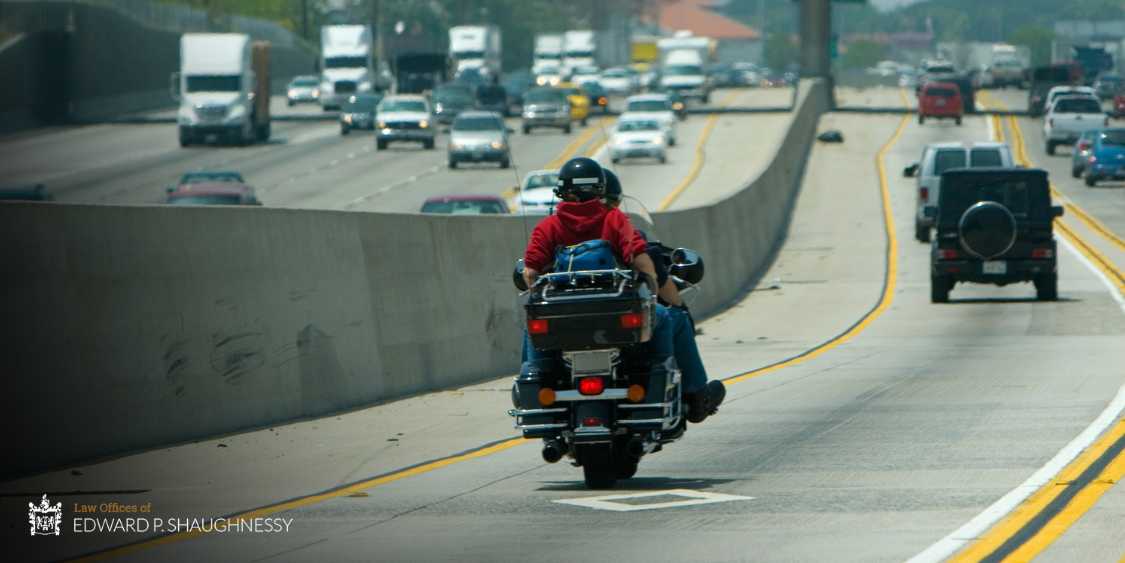Pennsylvania motorists often ask, “Is lane splitting legal in PA?” or “Is lane filtering legal in PA?”
It’s important to clarify that lane splitting, the practice where motorcyclists ride between two lanes of stopped or slowly moving vehicles on congested highways, is illegal in Pennsylvania. However, lane filtering is legal in Pennsylvania under certain conditions. Lane filtering allows motorcyclists to move between lanes of other vehicles that are stopped at an intersection, helping to reduce traffic congestion and enhance safety under specific circumstances.
The Easton auto accident lawyer team at Law Offices of Edward P. Shaughnessy has extensive experience with lane splitting and filtering claims in the Lehigh Valley area. Whether you’re a motorcyclist in Pennsylvania or were involved in a car accident with a motorcycle, the Easton motorcycle accident attorney can help. Contact the Law Offices of Edward P. Shaughnessy at 610-258-995 or contact us online to discuss your motorcycle accident case and understand your legal options in the state.
What is Lane Splitting?
Lane splitting is the act of a motorcycle moving between two lanes of traffic. This maneuver involves a motorcyclist riding along the line that separates two lanes, allowing them to ‘split’ lanes.
While lane splitting can help motorcyclists navigate through heavy traffic more quickly, lane splitting is illegal in many states, including Pennsylvania, due to safety concerns and the potential risks to motorcyclists and other vehicle drivers.
Lane Splitting vs. Lane Filtering in Pennsylvania
Lane splitting and lane filtering are two techniques motorcyclists use to navigate through traffic, but they have distinct differences and legal standings in Pennsylvania.
Lane splitting is the act of riding a motorcycle between two lanes of moving traffic, and it is illegal in Pennsylvania. The practice of lane splitting can be dangerous because it can lead to unexpected accidents due to the close proximity to moving vehicles.
On the other hand, lane filtering is legal in Pennsylvania under certain conditions. Lane filtering permits motorcyclists to navigate through stopped traffic at intersections, potentially reducing traffic congestion and the risk of rear-end collisions in slow or stopped traffic scenarios. Both motorcycle riders and drivers should be aware of these regulations to maintain safety and compliance on the roads.

Is Lane Splitting Legal in Pennsylvania?
Lane splitting, the practice where a motorcycle rides between lanes of traffic moving in the same direction, is not legal in Pennsylvania.
If a motorcyclist is caught lane splitting, it could result in receiving a ticket. This regulation applies to all motorcyclists and is intended to prevent accidents and injuries that can occur when motorcyclists navigate tightly between cars.
The restriction on lane splitting is enforced to ensure the safety of both motorcyclists and other road users, minimizing the risk of collisions in dense traffic situations.
Where is Lane Splitting Legal?
Lane splitting is legal in a few states across the United States, with California being the most notable example where it’s explicitly allowed. In California, motorcyclists can ‘lane split,’ where they ride the line between lanes of traffic on roads. This practice is seen as a way to alleviate traffic congestion and is legal under specific safety guidelines.
However, lane splitting remains illegal in many other states, including Pennsylvania.
How Many Motorcycles Can Use the Same Lane in Pennsylvania?
In Pennsylvania, lane sharing allows two motorcycles to ride side by side in the same lane on highways. This is a recognized and legal way for motorcyclists to share the road while occupying the width of a single lane in Pennsylvania
Lane sharing is distinct from lane splitting. Lane splitting involves riding between lanes of traffic and is illegal in Pennsylvania. In contrast, lane sharing involves two motorcycles using the same lane, which is perfectly legal. This lane-share practice can make motorcyclists more visible to other drivers, enhancing safety on the road, unlike the lane-split practice.
Is Motorcycle Lane Splitting Dangerous?
Motorcycle lane splitting is considered dangerous due to the proximity to other vehicles and the reduced space motorcyclists must maneuver. When riding between lanes of moving traffic, motorcyclists are at a higher risk of getting injured in an accident.
Lane splitting can result in collisions with cars that may change lanes unexpectedly or cannot see the motorcyclist. Injuries from an accident caused by lane splitting can be severe, highlighting why many states keep lane splitting illegal under their laws.
While lane splitting can offer the advantage of avoiding prolonged stays in traffic lines, it raises significant safety concerns. The act requires high skill levels and extreme caution from motorcyclists.
Lane filtering, legal in Pennsylvania, is a safer alternative to lane splitting, allowing motorcyclists to avoid traffic congestion without putting themselves in a vulnerable position on the road.
What Happens if You Get Into an Accident with Lane-Splitting Motorcyclists?
If you get into an accident involving a lane-splitting motorcyclist, the case’s specifics will be crucial in determining the outcome.
In states like Pennsylvania, where lane splitting is illegal, the motorcyclist may be found at fault due to the illegality of riding between lanes of traffic. However, each accident case is evaluated on its own merits, and liability can depend on the motorcyclist’s actions and other drivers involved.
If a motorcyclist is injured while lane splitting, the fact that they were engaging in an illegal maneuver can impact their ability to claim damages. Authorities will closely examine the circumstances of the accident, including the behavior of all parties and the exact movements that led to the collision, to determine fault and any potential legal repercussions.
Comparative Fault for Pennsylvania Motorcycle Accident Claims
In Pennsylvania, the concept of comparative fault applies to motorcycle accident claims, including those involving practices like lane splitting. Under this law, each party involved in an accident can be found partially at fault, depending on their actions.
For example, if a motorcyclist was lane splitting, which is illegal in Pennsylvania, and an accident occurs, they may be found to bear some degree of fault. However, if other factors, such as reckless driving by a car driver, contributed to the accident, the fault might also be assigned to that driver.
The damages a motorcyclist or driver can recover are reduced by their percentage of fault. This system aims to allocate damages to reflect each party’s responsibility in contributing to the accident, promoting safer driving and riding practices on Pennsylvania roads.

How an Easton Motorcycle Accident Lawyer Can Help
Consulting with a skilled Easton personal injury lawyer can significantly benefit your case if you’ve been involved in a motorcycle accident in Easton, PA. If your loved one passed away in a fatal accident, our fatal car accident lawyer in Easton will compassionately provide legal representation for your family.
An experienced attorney understands the complexities of motorcycle laws and can effectively deal with cases involving lane splitting and filtering. They can help assess the damages and losses incurred, ensuring you receive the compensation needed for recovery and future expenses.
If you or a loved one has been affected by a motorcycle accident, don’t hesitate to contact the Law Offices of Edward P. Shaughnessy. Call us at (610) 258-9955 or complete our online intake form to speak to a dedicated professional who can help protect your rights.






